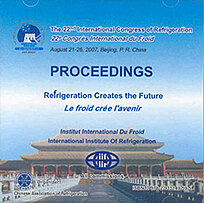
Document IIF
Analyse en termes de cycle de vie de la technologie des microcanaux et des échangeurs de chaleur compacts pour les systèmes frigorifiques.
Life cycle analysis of microchannel technology and compact heat exchangers for refrigerating units.
Auteurs : YOUBI-IDRISSI M., LEDUCQ D.
Résumé
In refrigerating and air-conditioning fields, the environmental performances of systems are frequently evaluated by using the TEWI indicator (Total Equivalent Warming Impact). Alone the greenhouse effect is taken into account from this widespread index which seems nevertheless to be inadequate for a global characterisation, including whole environmental impacts of a refrigerating machine during its life, i.e. from cradle to grave. In this article, the authors propose to apply the life cycle analysis approach to compare two refrigerating units, destined to an agro-food small application, having the same characteristics of refrigerating capacity and use the same refrigerant (R-404A). After a detailed life cycle inventory of both systems, the analysis results show that the use of the micro-channel technology and compact heat exchangers in such sector is energetically and environmentally friendly. It provides an energy saving, a low refrigerant charge, a significant CO2 emissions reduction (division by 3), in addition of an important decrease of other environmental impacts in terms of human health (33%), ecosystem quality (24%) and resources depletion (25%).
Documents disponibles
Format PDF
Pages : ICR07-B2-270
Disponible
Prix public
20 €
Prix membre*
Gratuit
* meilleur tarif applicable selon le type d'adhésion (voir le détail des avantages des adhésions individuelles et collectives)
Détails
- Titre original : Life cycle analysis of microchannel technology and compact heat exchangers for refrigerating units.
- Identifiant de la fiche : 2008-0418
- Langues : Anglais
- Sujet : Environnement, Généralités
- Source : ICR 2007. Refrigeration Creates the Future. Proceedings of the 22nd IIR International Congress of Refrigeration.
- Date d'édition : 21/08/2007
Liens
Voir d'autres communications du même compte rendu (839)
Voir le compte rendu de la conférence
Indexation
-
Thèmes :
Evaporateurs, condenseurs et autres échangeurs thermiques;
Généralités sur l'environnement (changements climatiques, appauvrissement de l'ozone…);
Circulation du fluide : tuyauterie, régulation, automatisme, sécurité - Mots-clés : TEWI; Système frigorifique; Consommation d'énergie; Microcanal; Longévité; Matériau; Environnement; Conditionnement d'air; Échangeur de chaleur
-
Use of HFC-410A in refrigeration plants to redu...
- Auteurs : RIVET P.
- Date : 06/04/2009
- Langues : Anglais
- Source : RCR 2009. 1st IIR Workshop on Refrigerant Charge Reduction in Refrigerating Systems.
- Formats : PDF
Voir la fiche
-
Refrigeration system with integrated liquid lin...
- Auteurs : LEDUCQ D., ROCHE C., MACCHI-TEJEDA H., et al.
- Date : 06/04/2009
- Langues : Anglais
- Source : RCR 2009. 1st IIR Workshop on Refrigerant Charge Reduction in Refrigerating Systems.
- Formats : PDF
Voir la fiche
-
The problems and prospects of development of TE...
- Auteurs : ZHELEZNY V. P., VOZNIY V. F., STEPANOVA V. P., et al.
- Date : 01/09/2004
- Langues : Anglais
- Source : Compressors 2004: 5th International Conference on Compressors and Coolants
- Formats : PDF
Voir la fiche
-
Ökoeffizienzbetrachtungen von Supermarktkältean...
- Auteurs : DIEHLMANN A., JAKOBS R., MEURER C.
- Date : 16/11/2005
- Langues : Allemand
- Source : DKV-Tagungsbericht 2005, Würzburg./ 2005 Proceedings of the DKV Conference, Würzburg.
Voir la fiche
-
Application of global temperature potential to ...
- Auteurs : COLBOURNE D., SUEN K. O.
- Date : 01/08/2004
- Langues : Anglais
- Source : Natural Working Fluids 2004: 6th IIR-Gustav Lorentzen Conference
- Formats : PDF
Voir la fiche
